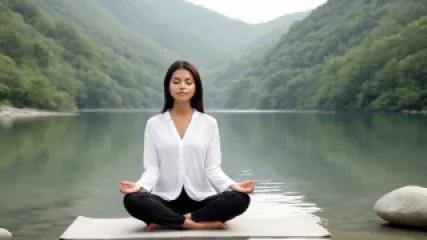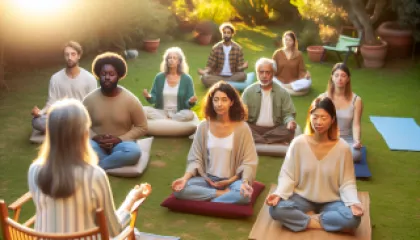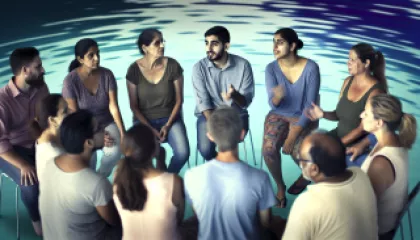The Ultimate Guide to Using Mindfulness for Anxiety Relief
The Ultimate Guide to Using Mindfulness for Anxiety Relief
In today's fast-paced and often overwhelming world, anxiety has become a common challenge for many individuals. Feeling constantly stressed, worried, or on edge can take a significant toll on our mental and physical well-being. However, there is a powerful tool that can help us navigate these anxious times with more ease and clarity: mindfulness.
Mindfulness is the practice of being present, aware, and non-judgmental in the moment. By cultivating a mindful mindset, we can learn to observe our thoughts and feelings without getting caught up in them, ultimately finding a sense of inner peace and clarity. In this comprehensive guide, we will explore the powerful intersection of mindfulness and anxiety relief, providing you with a practical roadmap to incorporate mindfulness into your life and find greater tranquility.
Understanding the Relationship Between Mindfulness and Anxiety
Anxiety is a natural human response to perceived threats or stressors, but when it becomes chronic and overwhelming, it can significantly impact our quality of life. Anxiety often manifests as physical symptoms, such as increased heart rate, sweating, and muscle tension, as well as mental and emotional symptoms, like rumination, worry, and feelings of dread.
Mindfulness, on the other hand, is the practice of being fully present and aware in the current moment, without judgment or attachment to the past or future. By cultivating a mindful mindset, we can learn to observe our thoughts and feelings with a sense of detachment, rather than getting caught up in the cycle of anxious thinking.
Research has shown that mindfulness can be a highly effective tool for managing anxiety. A study published in the Journal of the American Medical Association found that mindfulness-based interventions were as effective as traditional anxiety treatments, such as cognitive-behavioral therapy, in reducing anxiety symptoms. Goyal, M., et al. (2014). Meditation Programs for Psychological Stress and Well-being: A Systematic Review and Meta-analysis. JAMA Internal Medicine, 174(3), 357-368.
By learning to observe our thoughts and feelings with compassion and non-judgment, we can reduce the intensity and duration of anxious episodes, ultimately cultivating a greater sense of inner calm and resilience.
The Principles of Mindfulness
Mindfulness is rooted in several key principles that, when applied, can help us navigate anxiety with more ease and clarity. These principles include:
- Present Moment Awareness: Mindfulness is about being fully present and attentive to the here and now, rather than dwelling on the past or worrying about the future.
- Non-Judgment: Mindfulness encourages us to observe our thoughts and feelings without judgment, simply acknowledging them as they arise.
- Acceptance: Mindfulness teaches us to accept our experiences, both positive and negative, with a sense of openness and compassion.
- Beginner's Mind: Mindfulness encourages us to approach each moment with a sense of curiosity and wonder, as if experiencing it for the first time.
- Letting Go: Mindfulness helps us to let go of attachments and aversions, allowing us to move through life with greater ease and flexibility.
By incorporating these principles into our daily lives, we can cultivate a more mindful and grounded approach to managing anxiety.
Mindfulness Practices for Anxiety Relief
Incorporating mindfulness into your life can take many forms, and there is no one-size-fits-all approach. However, there are several specific mindfulness practices that have been shown to be particularly effective for managing anxiety. Let's explore some of these practices in detail:
Mindful Breathing
One of the most fundamental and accessible mindfulness practices is focused breathing. By turning our attention to the natural rhythm of our breath, we can calm the mind, reduce physical tension, and anchor ourselves in the present moment.
To practice mindful breathing, find a comfortable, quiet place to sit or lie down. Close your eyes (or keep them softly open if that feels more natural) and begin to notice the sensation of the breath moving in and out of your body. Observe the breath without trying to control it, simply allowing it to flow naturally. If your mind wanders, gently bring your attention back to the breath.
You can experiment with different breathing techniques, such as:
- Box Breathing: Inhale for 4 counts, hold for 4 counts, exhale for 4 counts, hold for 4 counts. Repeat.
- Alternate Nostril Breathing: Use your thumb and forefinger to gently close off one nostril, inhale through the other, then switch nostrils and exhale.
- Belly Breathing: Breathe deeply into your abdomen, allowing your belly to rise and fall with each inhalation and exhalation.
Mindful breathing can be practiced for as little as a few minutes a day, or incorporated into longer meditation sessions. The key is to make it a regular habit, allowing the breath to anchor you in the present moment and provide a sense of calm and clarity.
Body Scans
Another powerful mindfulness practice for anxiety relief is the body scan. This technique involves systematically bringing attention to different areas of the body, observing any sensations or tension that may be present.
To practice a body scan, begin by finding a comfortable seated or lying position. Close your eyes (or keep them softly open) and begin by tuning in to your breathing. Slowly shift your attention to the different parts of your body, starting with your toes and gradually moving up to the top of your head. Notice any areas of tension, discomfort, or relaxation, without judgment. If you find yourself becoming distracted, gently bring your attention back to the present moment.
Body scans can help us become more aware of the physical manifestations of anxiety, such as muscle tension or rapid heartbeat. By acknowledging these sensations with compassion, we can begin to release them, fostering a greater sense of physical and emotional calm.
Mindful Movement
While mindfulness is often associated with stillness and meditation, it can also be practiced through gentle movement. Incorporating mindful movement into your routine can be a powerful way to manage anxiety, as it combines the benefits of physical activity with the principles of present-moment awareness.
One of the most accessible forms of mindful movement is walking meditation. To practice, find a quiet, open space and begin slowly walking, maintaining a gentle, steady pace. As you walk, focus your attention on the sensations in your body, such as the feeling of your feet touching the ground or the movement of your limbs. Whenever your mind wanders, gently bring your attention back to the present moment.
You can also explore other forms of mindful movement, such as yoga, Tai Chi, or even simply stretching. The key is to approach the movement with a sense of presence and non-judgment, allowing the physical activity to serve as a meditation in motion.
Mindful Journaling
Writing can be a powerful tool for processing and releasing anxiety. Mindful journaling involves using the act of writing to cultivate present-moment awareness and self-reflection.
To practice mindful journaling, find a quiet space where you can write without distractions. Begin by taking a few deep breaths, then start writing about your current thoughts, feelings, and sensations. Avoid the temptation to censor or judge your writing; instead, approach it with a curious and non-judgmental mindset.
You can experiment with different journaling prompts, such as:
- Describing your current emotional state and any physical sensations you're experiencing
- Reflecting on a challenging situation you've faced and how you responded to it
- Expressing gratitude for the positive moments or people in your life
- Exploring your thoughts and feelings about the future in a compassionate way
Mindful journaling can help us gain insight into the root causes of our anxiety, process difficult emotions, and cultivate a greater sense of self-awareness and resilience.
Guided Meditations
For those new to mindfulness or struggling to establish a consistent practice, guided meditations can be a helpful tool. These recordings, led by experienced meditation teachers, provide a structured framework for practicing mindfulness, making it easier to stay focused and engaged.
Guided meditations can cover a wide range of topics, from anxiety-specific practices to more general mindfulness exercises. They often incorporate elements like focused breathing, body scans, and visualization techniques, guiding the listener through each step of the practice.
There are many free and paid resources available for guided meditations, including apps, websites, and audio recordings. Some popular options include:
- Calm: A widely-used meditation app with a library of guided meditations, including sessions specifically designed for anxiety relief.
- Insight Timer: A free app with thousands of guided meditations, talks, and music tracks from a diverse array of teachers and experts.
- Headspace: A subscription-based app that offers a structured learning program for mindfulness, including meditations for anxiety and stress management.
Experimenting with different guided meditations can help you find the approach that resonates most with you and your needs, making it easier to cultivate a regular mindfulness practice.
Integrating Mindfulness into Daily Life
While dedicated mindfulness practices, such as meditation and body scans, are incredibly valuable, the true power of mindfulness lies in its ability to be integrated into our everyday lives. By bringing present-moment awareness to our daily activities and routines, we can cultivate a more mindful and grounded approach to managing anxiety.
Mindful Everyday Activities
Mindfulness can be practiced during a wide range of everyday activities, from mundane tasks to more enjoyable pursuits. By bringing your full attention to the present moment, you can transform even the most routine actions into mindfulness exercises. Some examples of mindful everyday activities include:
- Mindful eating: Paying attention to the flavors, textures, and sensations of your food as you consume it, rather than eating mindlessly.
- Mindful walking: Observing the sensations in your body as you move, the sounds around you, and the sights that catch your eye.
- Mindful showering: Fully engaging with the experience of bathing, from the warmth of the water to the scent of your soap or shampoo.
- Mindful cleaning: Approaching household chores with a sense of presence, noticing the movements of your body and the changes in your environment.
By incorporating mindfulness into your daily routines, you can create opportunities for respite and renewal throughout your day, helping to manage anxiety in a more sustainable way.
Mindful Breaks and Transitions
In addition to mindful everyday activities, it's important to build in dedicated mindfulness breaks throughout your day. These can be as simple as taking a few deep breaths or as structured as a short meditation session.
Mindful breaks can be particularly helpful during periods of transition, such as:
- Before or after a stressful meeting or work task
- When moving from one activity to another
- During the morning and evening routines
- When experiencing a spike in anxiety or stress levels
By pausing to reconnect with the present moment, you can help interrupt the cycle of anxious thoughts and physical tension, allowing you to approach the next task or situation with greater clarity and composure.
Mindfulness in Relationships
Anxiety can also impact our relationships, leading to miscommunications, emotional distance, and conflict. Incorporating mindfulness into our interactions with others can be a powerful way to navigate these challenges.
Some ways to practice mindfulness in relationships include:
- Active listening: Giving your full attention to the other person, without planning your response or becoming distracted by your own thoughts.
- Emotional awareness: Tuning in to your own emotions and those of the other person, responding with empathy and understanding.
- Mindful communication: Choosing your words carefully, speaking from a place of authenticity and compassion.
- Letting go of judgment: Cultivating a non-judgmental attitude towards yourself and others, recognizing that everyone is on their own unique journey.
By bringing mindfulness to our relationships, we can deepen our connections, resolve conflicts more effectively, and find greater support and understanding during times of anxiety.
Mindfulness and Professional Support
While mindfulness can be a powerful tool for managing anxiety, it's important to recognize that it may not be a panacea for all anxious experiences. For some individuals, professional support may be necessary to address more complex or persistent anxiety issues.
Mindfulness-Based Therapies
Several evidence-based therapies have incorporated mindfulness as a core component, including:
- Mindfulness-Based Stress Reduction (MBSR): A program developed by Jon Kabat-Zinn that combines mindfulness meditation, body awareness, and yoga to help manage stress, pain, and illness.
- Mindfulness-Based Cognitive Therapy (MBCT): A treatment that integrates mindfulness practices with cognitive-behavioral therapy to prevent the recurrence of depression and anxiety.
- Acceptance and Commitment Therapy (ACT): A therapy that uses mindfulness, acceptance, and values-based living to help individuals overcome psychological barriers and create a meaningful life.
Working with a qualified mental health professional who specializes in these mindfulness-based approaches can be an invaluable resource for individuals struggling with anxiety, providing a structured and supportive framework for their mindfulness journey.
Seeking Additional Support
In addition to mindfulness-based therapies, there are other professional resources that can complement your mindfulness practice and provide additional support for anxiety management, such as:
- Counseling or psychotherapy: Working with a therapist can help you explore the root causes of your anxiety and develop personalized coping strategies.
- Support groups: Connecting with others who are navigating similar challenges can provide a sense of community and shared understanding.
- Medication management: In some cases, a combination of mindfulness and medication may be the most effective approach for managing chronic or severe anxiety.
It's important to remember that there is no one-size-fits-all solution for anxiety relief, and the path to greater well-being may involve a combination of different approaches. By working closely with healthcare professionals and embracing a holistic, mindful perspective, you can find the support and resources you need to manage anxiety and cultivate a more fulfilling, balanced life.
Conclusion: Embracing Mindfulness for Lifelong Anxiety Relief
In a world that often feels overwhelming and chaotic, the practice of mindfulness can be a transformative tool for managing anxiety and cultivating greater inner peace. By learning to observe our thoughts and feelings with compassion and non-judgment, we can break free from the cycle of anxious rumination and find a renewed sense of calm and clarity.
Through a variety of mindfulness practices, from focused breathing and body scans to mindful movement and journaling, we can develop the skills and strategies needed to navigate anxiety with more ease. And by integrating mindfulness into our daily lives, we can create a foundation of resilience and self-awareness that can support us through even the most challenging of circumstances.






